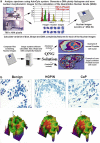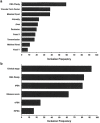Nuclear morphometry, epigenetic changes, and clinical relevance in prostate cancer
- PMID: 24563344
- PMCID: PMC7123969
- DOI: 10.1007/978-1-4899-8032-8_4
Nuclear morphometry, epigenetic changes, and clinical relevance in prostate cancer
Abstract
Nuclear structure alterations in cancer involve global genetic (mutations, amplifications, copy number variations, translocations, etc.) and epigenetic (DNA methylation and histone modifications) events that dramatically and dynamically spatially change chromatin, nuclear body, and chromosome organization. In prostate cancer (CaP) there appears to be early (<50 years) versus late (>60 years) onset clinically significant cancers, and we have yet to clearly understand the hereditary and somatic-based molecular pathways involved. We do know that once cancer is initiated, dedifferentiation of the prostate gland occurs with significant changes in nuclear structure driven by numerous genetic and epigenetic processes. This review focuses upon the nuclear architecture and epigenetic dynamics with potential translational clinically relevant applications to CaP. Further, the review correlates changes in the cancer-driven epigenetic process at the molecular level and correlates these alterations to nuclear morphological quantitative measurements. Finally, we address how we can best utilize this knowledge to improve the efficacy of personalized treatment of cancer.
Figures




Similar articles
-
Advances in the computational and molecular understanding of the prostate cancer cell nucleus.J Cell Biochem. 2018 Sep;119(9):7127-7142. doi: 10.1002/jcb.27156. Epub 2018 Jun 20. J Cell Biochem. 2018. PMID: 29923622 Free PMC article. Review.
-
The expanding role of epigenetics in the development, diagnosis and treatment of prostate cancer and benign prostatic hyperplasia.J Urol. 2007 Mar;177(3):822-31. doi: 10.1016/j.juro.2006.10.063. J Urol. 2007. PMID: 17296351 Review.
-
Epigenetic modifications in prostate cancer.Epigenomics. 2014;6(4):415-26. doi: 10.2217/epi.14.34. Epigenomics. 2014. PMID: 25333850 Review.
-
Epigenetic events, remodelling enzymes and their relationship to chromatin organization in prostatic intraepithelial neoplasia and prostatic adenocarcinoma.BJU Int. 2007 Apr;99(4):908-15. doi: 10.1111/j.1464-410X.2006.06704.x. BJU Int. 2007. PMID: 17378849
-
Prostate cancer epigenetics and its clinical implications.Asian J Androl. 2016 Jul-Aug;18(4):549-58. doi: 10.4103/1008-682X.179859. Asian J Androl. 2016. PMID: 27212125 Free PMC article. Review.
Cited by
-
Data-Efficient Computational Pathology Platform for Faster and Cheaper Breast Cancer Subtype Identifications: Development of a Deep Learning Model.JMIR Cancer. 2023 Sep 5;9:e45547. doi: 10.2196/45547. JMIR Cancer. 2023. PMID: 37669090 Free PMC article.
-
3D Shape Modeling for Cell Nuclear Morphological Analysis and Classification.Sci Rep. 2018 Sep 12;8(1):13658. doi: 10.1038/s41598-018-31924-2. Sci Rep. 2018. PMID: 30209281 Free PMC article.
-
Autophagy and nuclear morphometry are associated with histopathologic features in esophageal squamous cell carcinoma.J Mol Med (Berl). 2024 Jan;102(1):39-52. doi: 10.1007/s00109-023-02387-4. Epub 2023 Oct 25. J Mol Med (Berl). 2024. PMID: 37878028
-
Advances in the computational and molecular understanding of the prostate cancer cell nucleus.J Cell Biochem. 2018 Sep;119(9):7127-7142. doi: 10.1002/jcb.27156. Epub 2018 Jun 20. J Cell Biochem. 2018. PMID: 29923622 Free PMC article. Review.
-
Assessment of the Utility of Gene Positioning Biomarkers in the Stratification of Prostate Cancers.Front Genet. 2019 Oct 17;10:1029. doi: 10.3389/fgene.2019.01029. eCollection 2019. Front Genet. 2019. PMID: 31681438 Free PMC article.
References
-
- Virchow R. Cellular pathology as based upon physiological and pathological histology. Philadelphia, PA: J B Lippincott; 1863. - PubMed
-
- Beale L. Examination of sputum from a case of cancer of the pharynx and the adjacent parts. Arch Med (Lond) 1860;2:44–46.
-
- Long SR, Cohen MB. Classics in cytology. VI: the early cytologic discoveries of Lionel S. Beale. Diagn Cytopathol. 1993;9(5):595–598. - PubMed
-
- Cremer T, Cremer C. Rise, fall and resurrection of chromosome territories: a historical perspective. Part II. Fall and resurrection of chromosome territories during the 1950s to 1980s. Part III. Chromosome territories and the functional nuclear architecture: experiments and models from the 1990s to the present. Eur J Histochem. 2006;50(4):223–272. - PubMed
-
- Cremer T, Cremer C. Rise, fall and resurrection of chromosome territories: a historical perspective. Part I. The rise of chromosome territories. Eur J Histochem. 2006;50(3):161–176. - PubMed
MeSH terms
LinkOut - more resources
Full Text Sources
Other Literature Sources
Medical
Miscellaneous

